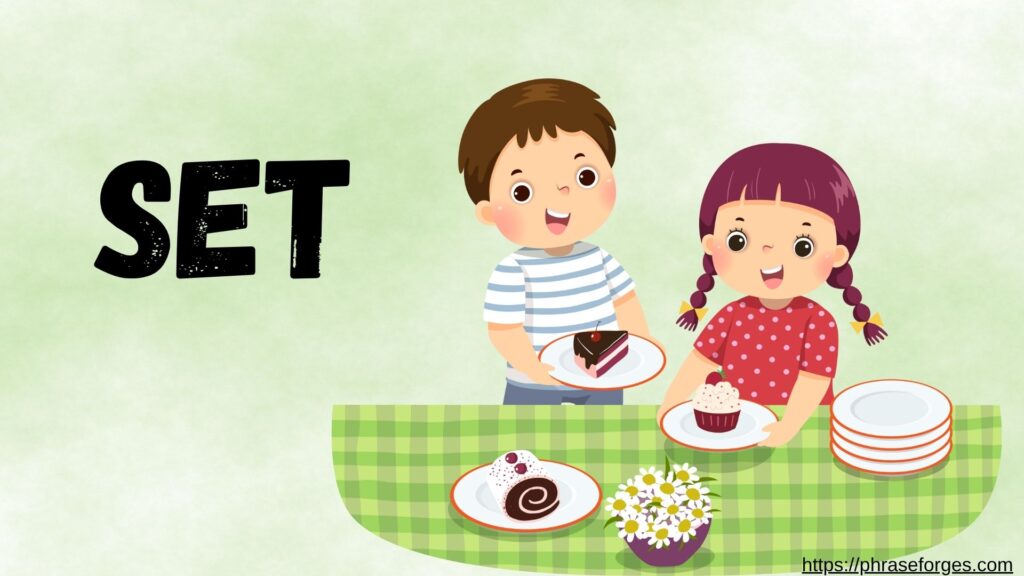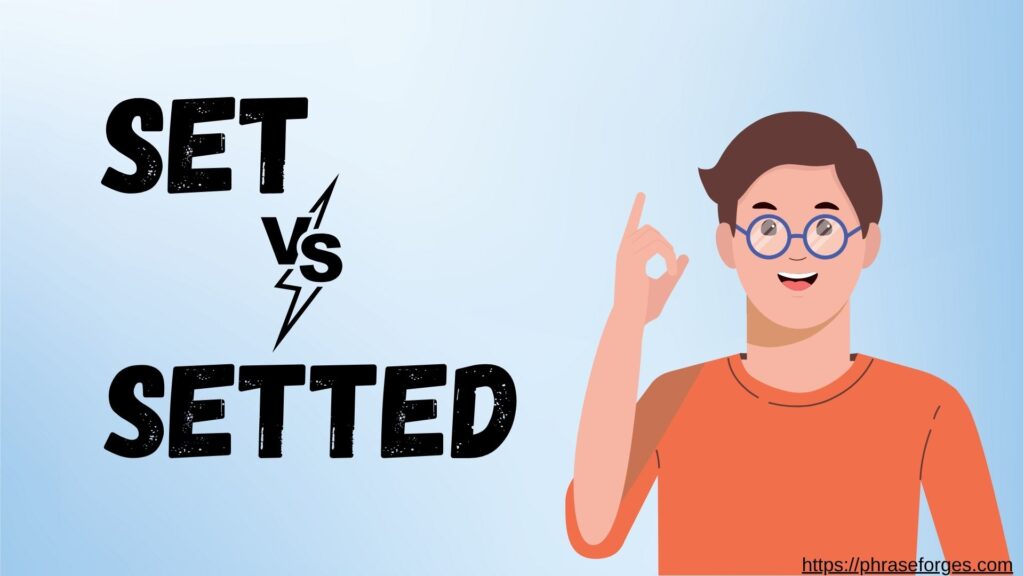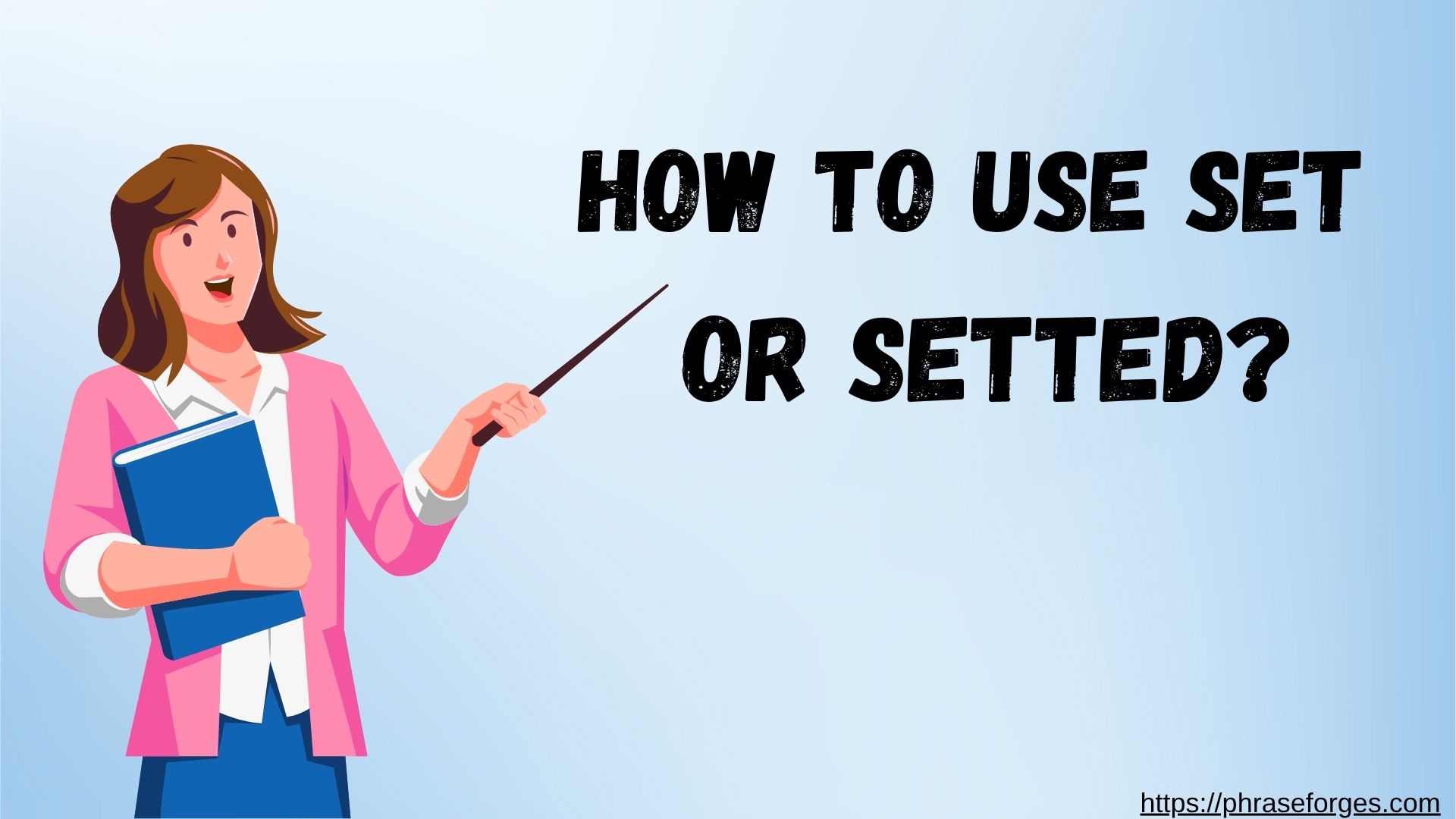Keyword + Intro Explanation
If you’ve ever paused mid-sentence wondering, “Is it set or setted?” you’re not alone. English verbs can be a tricky bunch, especially irregular verbs like set that don’t follow the usual rules. Add in the confusion of similar words like cut, hit, or shut, and suddenly grammar feels like a guessing game.
Here’s the good news: this isn’t as hard as it seems. By the end of this guide, you’ll understand how to use “set” in all tenses, why “setted” is incorrect, and how to avoid the most common grammar pitfalls around this powerful little verb.
Simple Definition + Usage Overview

The verb set means to place something carefully or intentionally somewhere, but it has many meanings depending on context. For instance:
- Set the table (prepare it for a meal)
- Set a goal (establish a target)
- Set an alarm (configure a device)
Here’s where it gets interesting: unlike most English verbs, set is a no-change irregular verb. That means its present, past, and past participle forms are all the same: set.
| Tense | Verb Form |
|---|---|
| Present | set |
| Past | set |
| Past Participle | set |
| Present Participle | setting |
| Third-Person Singular | sets |
So, it’s always set, not setted no matter the tense.
Clear Rules & Patterns
✅ Correct Forms of “Set”
- Present: I set my phone down.
- Past: She set the plates on the table.
- Past participle: They have set their sights on a new project.
❌ Incorrect Form
- ✘ I setted the alarm clock. (Wrong!)
- ✔ I set the alarm clock. (Correct!)
Bulleted Rules with Do’s & Don’ts
✅ Do:
- Use “set” in the past: “He set the record last year.”
- Use helper verbs like have, has, had with set in perfect tenses.
- Use “setting” for present continuous: “She is setting the table.”
❌ Don’t:
- Say “setted” it’s not a word.
- Confuse past participle with present participle.
- Use “sets” in past tense sentences.
Multiple Example Sentences
Let’s take a look at how “set” fits into different tenses:
- Present Tense:
I usually set my alarm for 6 a.m. - Past Tense:
Yesterday, I set my tools down after work. - Present Perfect Tense:
They have set a new sales record this quarter. - Past Perfect Tense:
By the time we arrived, they had set everything up. - Future Tense:
She will set the table before dinner. - Present Continuous Tense:
He is setting the stage for the play. - Future Perfect Continuous:
By tomorrow morning, I will have been setting up the room for five hours.
Scenario Example: Email (Job Task Update)
Subject: Task Completion Update Launch Prep
Hi Jordan,
Just a quick update I’ve set the product launch schedule for review and shared it in the team drive. I also set a meeting for 10:30 a.m. tomorrow to finalize our demo prep.
Please let me know if any adjustments are needed.
Thanks,
Elena
Before/After Examples in Everyday and Formal Contexts
| Context | Incorrect (Before) | Correct (After) |
|---|---|---|
| Casual Text | “I just setted my alarm.” | “I just set my alarm.” |
| Office Email | “We setted the project.” | “We set the project.” |
| School Essay | “The teacher setted rules.” | “The teacher set rules.” |
Notice how the incorrect versions just sound… off? That’s because they break natural English patterns.
Common Mistakes & Fixes
❌ Mistake 1: Using “Setted” in Past Tense
- Wrong: “He setted the laptop on the desk.”
- Fix: “He set the laptop on the desk.”
❌ Mistake 2: Using “Setted” with Perfect Tenses
- Wrong: “She had setted everything up already.”
- Fix: “She had set everything up already.”
❌ Mistake 3: Confusing Continuous with Past
- Wrong: “I was set the table.”
- Fix: “I was setting the table.”
Quick Reference Table
| Tense | Example | Correct Verb Form |
|---|---|---|
| Simple Present | I set goals weekly. | set |
| Simple Past | She set the schedule yesterday. | set |
| Present Perfect | They have set expectations. | set |
| Past Perfect | We had set the date in advance. | set |
| Future | He will set it up later. | set |
| Present Continuous | I am setting up now. | setting |
| Past Continuous | She was setting the plates. | setting |
| Future Perfect Continuous | He will have been setting goals all month. | setting |
Etymology & Historical Context
The verb “set” has been in use for centuries. It comes from the Old English “settan”, which is related to the Proto-Germanic *(bi)satejanan, meaning to cause to sit, to put in place. Over time, “set” evolved into a no-change irregular verb, just like cut, hit, and shut.
These verbs share a curious feature: their forms stay the same, no matter the tense. That’s why you say, “He cut his finger,” not “He cutted his finger.”
Set vs Setted — Final Verdict

Let’s drive this home.
- The correct form is always set, whether you’re talking about the past, present, or past participle.
- Setted is not recognized in standard English. Using it in writing or conversation will come across as a grammar mistake.
- The verb set is part of a rare group of no-change irregular verbs memorize them, and you’ll instantly sound more fluent.
Closing Thought
In English grammar, understanding verbs like “set” and why “setted” is wrong will help you avoid common slip-ups, especially in professional or academic writing. Next time you’re drafting an email, writing an essay, or giving directions, you’ll know exactly how to use “set” with confidence.
If you’re ever in doubt, remember:
“Set is set in stone it never changes.”

